Once a sport has at least three trophies, their worlds invariably become enamored by the idea of a triple crown. American horse racing, baseball, and European soccer all have their own three-trophy achievement by one name or another. Auto racing has a few, but the most famous ties together three ancient races: the Grand Prix of Monaco, the 24 Hours of Le Mans, and the Indianapolis 500.
The very idea of a triple crown misses the point. Monaco is a great race, but it is one of 24 Formula 1 rounds and one of a half-dozen that trace their history back to a pre-war era of Grand Prix racing. Those old European rounds are all highlights, but they are far less significant than F1’s world championship. They are not meaningful single-day prizes, just crown jewels in the world’s biggest racing championship.
Le Mans and the 500, by contrast, dwarf their respective championships. The series that organize the 500-mile and 24-hour classics date back to just 1996 and 2013, respectively. These races have a remarkable staying power, keeping their popularity and significance across collapsing championships, waves of waning automaker interest, and all the societal shifts that come with the passage of time. These are races big enough that they have repeatedly kept their entire discipline, whether that is sports car racing or a unique and separate culture of American open-wheel racing, afloat.
The size is a big part of it. Each draws a massive one-day crowd, well above 300,000 in the modern era. That dwarfs even the hugely popular 24 Hours of Nurburgring, let alone single-day attendance of any given Formula 1 GP, NASCAR race, or anything else. Those crowds understand the significance of the moment and the immortality of the prize at stake, but they also, simply, understand the appeal of an event of that size.
Those crowds are also notoriously rowdy, although that may be a simple factor of what happens when 300,000 people are in the same place. At the Indianapolis 500, the famous debauchery of “Coke Lot” campsites and the Snake Pit infield concert have been part of the appeal for decades. Le Mans has its own quirks, from similarly rowdy off-track festivities to TVRs and 1960s Aston Martins parked alongside tents in grassy fields deep in the track’s countryside infield. These races are pilgrimages, often ones that individual groups of fans make every year for decades.
Accepting just the two races as equivalent to a triple crown does not change the prestige of winning both, either. It is a feat that only AJ Foyt and Graham Hill, two of the greatest drivers of the 1960s golden age of auto racing, have accomplished. If you count class wins, and you should not, the only other addition is Juan Pablo Montoya. Either way, it is a short list filled only with unimpeachable talent.
Historically, these single races drive innovation. The first Indianapolis 500 saw the first notable application of a rear-view mirror, and by the late 1960s, it was a race that could be led by a car with a gas turbine. Disc brakes and fuel injection were popularized after their appearances at Le Mans in 1952, and unlike the 500, that tradition of innovation has continued. Diesel powertrains won in the 2000s, and a wide variety of ultra-complex hybrids joined the grid in the 2010s. Hybrids storing kinetic energy in a flywheel, supercapacitors, and batteries have all won the race in the past decade.
On track, the second centuries at Le Mans and Indianapolis have set the races apart even further. This year’s Formula 1 championship is setting up to be more competitive than the past two Verstappen runaways, but the Monaco Grand Prix saw so few passes that the points-scoring positions finished in the order that they started. At Le Mans, the most competitive race in event history saw the record number of lead lap finishers. The Indianapolis 500 was won on a last-lap pass, just two corners after another last-lap pass.
That kind of action is part of what draws such massive crowds. 329,000 fans attended a sell-out at the Circuit de la Sarthe in June. 345,000 came to Indy, a near-miss of a sellout at one of the biggest venues on Earth. These special events draw special crowds, in no small part because they produce special races.
Le Mans and Indianapolis, and only Le Mans and Indianapolis, are immortal racing prizes that can be won in one single race. No race, in Formula 1 or otherwise, can compare. A championship may be bigger, but it is not the same sort of achievement. These are trophies won or lost over one single event, every single year.

Fred Smith’s love of cars comes from his fascination with auto racing. Unfortunately, that passion led him to daily drive a high-mileage, first-year Porsche Panamera. He is still thinking about the last lap of the 2011 Indianapolis 500.
Once a sport has at least three trophies, their worlds invariably become enamored by the idea of a triple crown. American horse racing, baseball, and European soccer all have their own three-trophy achievement by one name or another. Auto racing has a few, but the most famous ties together three ancient races: the Grand Prix of Monaco, the 24 Hours of Le Mans, and the Indianapolis 500.
The very idea of a triple crown misses the point. Monaco is a great race, but it is one of 24 Formula 1 rounds and one of a half-dozen that trace their history back to a pre-war era of Grand Prix racing. Those old European rounds are all highlights, but they are far less significant than F1’s world championship. They are not meaningful single-day prizes, just crown jewels in the world’s biggest racing championship.
Le Mans and the 500, by contrast, dwarf their respective championships. The series that organize the 500-mile and 24-hour classics date back to just 1996 and 2013, respectively. These races have a remarkable staying power, keeping their popularity and significance across collapsing championships, waves of waning automaker interest, and all the societal shifts that come with the passage of time. These are races big enough that they have repeatedly kept their entire discipline, whether that is sports car racing or a unique and separate culture of American open-wheel racing, afloat.
The size is a big part of it. Each draws a massive one-day crowd, well above 300,000 in the modern era. That dwarfs even the hugely popular 24 Hours of Nurburgring, let alone single-day attendance of any given Formula 1 GP, NASCAR race, or anything else. Those crowds understand the significance of the moment and the immortality of the prize at stake, but they also, simply, understand the appeal of an event of that size.
Those crowds are also notoriously rowdy, although that may be a simple factor of what happens when 300,000 people are in the same place. At the Indianapolis 500, the famous debauchery of “Coke Lot” campsites and the Snake Pit infield concert have been part of the appeal for decades. Le Mans has its own quirks, from similarly rowdy off-track festivities to TVRs and 1960s Aston Martins parked alongside tents in grassy fields deep in the track’s countryside infield. These races are pilgrimages, often ones that individual groups of fans make every year for decades.
Accepting just the two races as equivalent to a triple crown does not change the prestige of winning both, either. It is a feat that only AJ Foyt and Graham Hill, two of the greatest drivers of the 1960s golden age of auto racing, have accomplished. If you count class wins, and you should not, the only other addition is Juan Pablo Montoya. Either way, it is a short list filled only with unimpeachable talent.
Historically, these single races drive innovation. The first Indianapolis 500 saw the first notable application of a rear-view mirror, and by the late 1960s, it was a race that could be led by a car with a gas turbine. Disc brakes and fuel injection were popularized after their appearances at Le Mans in 1952, and unlike the 500, that tradition of innovation has continued. Diesel powertrains won in the 2000s, and a wide variety of ultra-complex hybrids joined the grid in the 2010s. Hybrids storing kinetic energy in a flywheel, supercapacitors, and batteries have all won the race in the past decade.
On track, the second centuries at Le Mans and Indianapolis have set the races apart even further. This year’s Formula 1 championship is setting up to be more competitive than the past two Verstappen runaways, but the Monaco Grand Prix saw so few passes that the points-scoring positions finished in the order that they started. At Le Mans, the most competitive race in event history saw the record number of lead lap finishers. The Indianapolis 500 was won on a last-lap pass, just two corners after another last-lap pass.
That kind of action is part of what draws such massive crowds. 329,000 fans attended a sell-out at the Circuit de la Sarthe in June. 345,000 came to Indy, a near-miss of a sellout at one of the biggest venues on Earth. These special events draw special crowds, in no small part because they produce special races.
Le Mans and Indianapolis, and only Le Mans and Indianapolis, are immortal racing prizes that can be won in one single race. No race, in Formula 1 or otherwise, can compare. A championship may be bigger, but it is not the same sort of achievement. These are trophies won or lost over one single event, every single year.

Fred Smith’s love of cars comes from his fascination with auto racing. Unfortunately, that passion led him to daily drive a high-mileage, first-year Porsche Panamera. He is still thinking about the last lap of the 2011 Indianapolis 500.
Once a sport has at least three trophies, their worlds invariably become enamored by the idea of a triple crown. American horse racing, baseball, and European soccer all have their own three-trophy achievement by one name or another. Auto racing has a few, but the most famous ties together three ancient races: the Grand Prix of Monaco, the 24 Hours of Le Mans, and the Indianapolis 500.
The very idea of a triple crown misses the point. Monaco is a great race, but it is one of 24 Formula 1 rounds and one of a half-dozen that trace their history back to a pre-war era of Grand Prix racing. Those old European rounds are all highlights, but they are far less significant than F1’s world championship. They are not meaningful single-day prizes, just crown jewels in the world’s biggest racing championship.
Le Mans and the 500, by contrast, dwarf their respective championships. The series that organize the 500-mile and 24-hour classics date back to just 1996 and 2013, respectively. These races have a remarkable staying power, keeping their popularity and significance across collapsing championships, waves of waning automaker interest, and all the societal shifts that come with the passage of time. These are races big enough that they have repeatedly kept their entire discipline, whether that is sports car racing or a unique and separate culture of American open-wheel racing, afloat.
The size is a big part of it. Each draws a massive one-day crowd, well above 300,000 in the modern era. That dwarfs even the hugely popular 24 Hours of Nurburgring, let alone single-day attendance of any given Formula 1 GP, NASCAR race, or anything else. Those crowds understand the significance of the moment and the immortality of the prize at stake, but they also, simply, understand the appeal of an event of that size.
Those crowds are also notoriously rowdy, although that may be a simple factor of what happens when 300,000 people are in the same place. At the Indianapolis 500, the famous debauchery of “Coke Lot” campsites and the Snake Pit infield concert have been part of the appeal for decades. Le Mans has its own quirks, from similarly rowdy off-track festivities to TVRs and 1960s Aston Martins parked alongside tents in grassy fields deep in the track’s countryside infield. These races are pilgrimages, often ones that individual groups of fans make every year for decades.
Accepting just the two races as equivalent to a triple crown does not change the prestige of winning both, either. It is a feat that only AJ Foyt and Graham Hill, two of the greatest drivers of the 1960s golden age of auto racing, have accomplished. If you count class wins, and you should not, the only other addition is Juan Pablo Montoya. Either way, it is a short list filled only with unimpeachable talent.
Historically, these single races drive innovation. The first Indianapolis 500 saw the first notable application of a rear-view mirror, and by the late 1960s, it was a race that could be led by a car with a gas turbine. Disc brakes and fuel injection were popularized after their appearances at Le Mans in 1952, and unlike the 500, that tradition of innovation has continued. Diesel powertrains won in the 2000s, and a wide variety of ultra-complex hybrids joined the grid in the 2010s. Hybrids storing kinetic energy in a flywheel, supercapacitors, and batteries have all won the race in the past decade.
On track, the second centuries at Le Mans and Indianapolis have set the races apart even further. This year’s Formula 1 championship is setting up to be more competitive than the past two Verstappen runaways, but the Monaco Grand Prix saw so few passes that the points-scoring positions finished in the order that they started. At Le Mans, the most competitive race in event history saw the record number of lead lap finishers. The Indianapolis 500 was won on a last-lap pass, just two corners after another last-lap pass.
That kind of action is part of what draws such massive crowds. 329,000 fans attended a sell-out at the Circuit de la Sarthe in June. 345,000 came to Indy, a near-miss of a sellout at one of the biggest venues on Earth. These special events draw special crowds, in no small part because they produce special races.
Le Mans and Indianapolis, and only Le Mans and Indianapolis, are immortal racing prizes that can be won in one single race. No race, in Formula 1 or otherwise, can compare. A championship may be bigger, but it is not the same sort of achievement. These are trophies won or lost over one single event, every single year.

Fred Smith’s love of cars comes from his fascination with auto racing. Unfortunately, that passion led him to daily drive a high-mileage, first-year Porsche Panamera. He is still thinking about the last lap of the 2011 Indianapolis 500.
Once a sport has at least three trophies, their worlds invariably become enamored by the idea of a triple crown. American horse racing, baseball, and European soccer all have their own three-trophy achievement by one name or another. Auto racing has a few, but the most famous ties together three ancient races: the Grand Prix of Monaco, the 24 Hours of Le Mans, and the Indianapolis 500.
The very idea of a triple crown misses the point. Monaco is a great race, but it is one of 24 Formula 1 rounds and one of a half-dozen that trace their history back to a pre-war era of Grand Prix racing. Those old European rounds are all highlights, but they are far less significant than F1’s world championship. They are not meaningful single-day prizes, just crown jewels in the world’s biggest racing championship.
Le Mans and the 500, by contrast, dwarf their respective championships. The series that organize the 500-mile and 24-hour classics date back to just 1996 and 2013, respectively. These races have a remarkable staying power, keeping their popularity and significance across collapsing championships, waves of waning automaker interest, and all the societal shifts that come with the passage of time. These are races big enough that they have repeatedly kept their entire discipline, whether that is sports car racing or a unique and separate culture of American open-wheel racing, afloat.
The size is a big part of it. Each draws a massive one-day crowd, well above 300,000 in the modern era. That dwarfs even the hugely popular 24 Hours of Nurburgring, let alone single-day attendance of any given Formula 1 GP, NASCAR race, or anything else. Those crowds understand the significance of the moment and the immortality of the prize at stake, but they also, simply, understand the appeal of an event of that size.
Those crowds are also notoriously rowdy, although that may be a simple factor of what happens when 300,000 people are in the same place. At the Indianapolis 500, the famous debauchery of “Coke Lot” campsites and the Snake Pit infield concert have been part of the appeal for decades. Le Mans has its own quirks, from similarly rowdy off-track festivities to TVRs and 1960s Aston Martins parked alongside tents in grassy fields deep in the track’s countryside infield. These races are pilgrimages, often ones that individual groups of fans make every year for decades.
Accepting just the two races as equivalent to a triple crown does not change the prestige of winning both, either. It is a feat that only AJ Foyt and Graham Hill, two of the greatest drivers of the 1960s golden age of auto racing, have accomplished. If you count class wins, and you should not, the only other addition is Juan Pablo Montoya. Either way, it is a short list filled only with unimpeachable talent.
Historically, these single races drive innovation. The first Indianapolis 500 saw the first notable application of a rear-view mirror, and by the late 1960s, it was a race that could be led by a car with a gas turbine. Disc brakes and fuel injection were popularized after their appearances at Le Mans in 1952, and unlike the 500, that tradition of innovation has continued. Diesel powertrains won in the 2000s, and a wide variety of ultra-complex hybrids joined the grid in the 2010s. Hybrids storing kinetic energy in a flywheel, supercapacitors, and batteries have all won the race in the past decade.
On track, the second centuries at Le Mans and Indianapolis have set the races apart even further. This year’s Formula 1 championship is setting up to be more competitive than the past two Verstappen runaways, but the Monaco Grand Prix saw so few passes that the points-scoring positions finished in the order that they started. At Le Mans, the most competitive race in event history saw the record number of lead lap finishers. The Indianapolis 500 was won on a last-lap pass, just two corners after another last-lap pass.
That kind of action is part of what draws such massive crowds. 329,000 fans attended a sell-out at the Circuit de la Sarthe in June. 345,000 came to Indy, a near-miss of a sellout at one of the biggest venues on Earth. These special events draw special crowds, in no small part because they produce special races.
Le Mans and Indianapolis, and only Le Mans and Indianapolis, are immortal racing prizes that can be won in one single race. No race, in Formula 1 or otherwise, can compare. A championship may be bigger, but it is not the same sort of achievement. These are trophies won or lost over one single event, every single year.

Fred Smith’s love of cars comes from his fascination with auto racing. Unfortunately, that passion led him to daily drive a high-mileage, first-year Porsche Panamera. He is still thinking about the last lap of the 2011 Indianapolis 500.


















